Environmental Impacts of Egg Production from a Life Cycle Perspective
Abstract
:1. Introduction
2. Materials and Methods
2.1. Goal and Scope of the Study
2.1.1. Objective and Functional Unit
2.1.2. System Description
2.1.3. System Boundaries
2.1.4. Allocation
2.2. Life Cycle Inventory
2.2.1. Data Sources
2.2.2. Assumptions
2.2.3. Calculations of Emissions
2.2.4. Data Inventory
2.3. Life Cycle Impact Assessment
2.4. Alternative Scenarios
3. Results
3.1. Life Cycle Inventory of Resource Use
3.2. Impact Assessment of Laying Systems
3.2.1. Feed
3.2.2. Hatchery
3.2.3. Rearing
3.2.4. Laying
3.2.5. Transport
3.2.6. Energy
3.3. Impact Assessment of the Community Garden
3.4. Alternative Scenarios
3.4.1. Scenario 1
3.4.2. Scenario 2
4. Discussion
5. Conclusions
Supplementary Materials
Author Contributions
Funding
Institutional Review Board Statement
Informed Consent Statement
Data Availability Statement
Acknowledgments
Conflicts of Interest
References
- Benelam, B.; Roe, M.A.; Pinchen, H.; Church, S.; Buttriss, J.L.; Gray, J.; Farron-Wilson, M.; Finglas, P.M. New data on the nutritional composition of UK hens’ eggs. Nutr. Bull. 2012, 37, 344–349. [Google Scholar] [CrossRef]
- Committee for the Common Organisation of the Agricultural Market. EU Market Situation for Eggs; European Commission: Brussels, Belgium, 2021. [Google Scholar]
- Poore, J.; Nemecek, T. Reducing food’s environmental impacts through producers and consumers. Science 2018, 360, 987–992. [Google Scholar] [CrossRef] [Green Version]
- Clark, M.A.; Springmann, M.; Hill, J.; Tilman, D. Multiple health and environmental impacts of foods. Proc. Natl. Acad. Sci. USA 2019, 116, 23357–23362. [Google Scholar] [CrossRef] [PubMed] [Green Version]
- Abín, R.; Laca, A.; Diaz, M. Environmental assesment of intensive egg production: A Spanish case study. J. Clean. Prod. 2018, 179, 160–168. [Google Scholar] [CrossRef]
- Costantini, M.; Lovarelli, D.; Orsi, L.; Ganzaroli, A.; Ferrante, V.; Febo, P.; Guarino, M.; Bacenetti, J. Investigating on the environmental sustainability of organic animal products? The case of organic eggs. J. Clean. Prod. 2020, 274, 123046. [Google Scholar] [CrossRef]
- Ghasempour, A.; Ahmadi, E. Assessment of environment impacts of egg production chain using life cycle assessment. J. Environ. Manag. 2016, 183, 980–987. [Google Scholar] [CrossRef] [PubMed]
- Wiedemann, S.G.; McGahan, E.J. Environmental Assessment of an Egg Production Supply Chain using Life Cycle Assessment; Australian Egg Corporation Limited: Sydney, Australia, 2010. [Google Scholar]
- Dekker, S.; Boer, I.J.M.; Vermeij, I.; Aarnink, A.; Groot Koerkamp, P.W.G. Ecological and economic evaluation of Dutch egg production systems. Livest. Sci. 2011, 139, 109–121. [Google Scholar] [CrossRef]
- Leinonen, I.; Williams, A.G.; Wiseman, J.; Guy, J.; Kyriazakis, I. Predicting the environmental impacts of chicken systems in the United Kingdom through a life cycle assessment: Egg production systems. Poult. Sci. 2012, 91, 26–40. [Google Scholar] [CrossRef]
- Pelletier, N. Life cycle assessment of Canadian egg products, with differentiation by hen housing system type. J. Clean. Prod. 2017, 152, 167–180. [Google Scholar] [CrossRef]
- Roy, P.; Nei, D.; Orikasa, T.; Xu, Q.; Okadome, H.; Nakamura, N.; Shiina, T. A review of life cycle assessment (LCA) on some food products. J. Food Eng. 2009, 90, 1–10. [Google Scholar] [CrossRef]
- European Commission. Commission Implementing Regulation of 15.2.2021 Amending Regulation (EC) No 889/2008 Laying down Detailed Rules for the Implementation of Council Regulation (EC) No 834/2007 on Organic Production and Labelling of Organic Products with Regard to Organic Production, Labelling and Control; Official Journal of the European Union: Brussels, Belgium, 2021. [Google Scholar]
- Czech Statistical Office. Average Agricultural Prices. Available online: https://vdb.czso.cz/vdbvo2/faces/en/index.jsf?page=vystup-objekt-vyhledavani&vyhltext=egg&bkvt=ZWdn&katalog=all&skupId=1573&pvo=CEN02A#w= (accessed on 10 January 2022).
- Czech Environmental Information Agency. Projects Situated in the Czech Territory. Available online: https://portal.cenia.cz/eiasea/view/eia100_cr?lang=en (accessed on 29 November 2021).
- Wernet, G.; Bauer, C.; Steubing, B.; Reinhard, J.; Moreno-Ruiz, E.; Weidema, B. The ecoinvent database version 3 (part I): Overview and methodology. Int. J. Life Cycle Assess. 2016, 21, 1218–1230. [Google Scholar] [CrossRef]
- PE International. GaBi: Software and Database Contents for Life Cycle Engineering; PE International: Stuttgart, Germany, 2012. [Google Scholar]
- Skunca, D.; Tomasevic, I.; Nastasijevic, I.; Tomovic, V.; Djekic, I. Life cycle assessment of the chicken meat chain. J. Clean. Prod. 2018, 184, 440–450. [Google Scholar] [CrossRef]
- Feedipedia—Animal Feed Resources Information System. Available online: https://www.feedipedia.org/search/node/corn (accessed on 10 January 2022).
- IPCC. Guidelines for National Greenhouse Gas Inventories; Intergovernmental Panel on Climate Change: Geneva, Switzerland; IGES: Tokyo, Japan, 2006. [Google Scholar]
- Santonja, G.G.; Georgitzikis, K.; Scalet, B.M.; Montobbio, P.; Roudier, S.; Sancho, L.D. Best Available Techniques (BAT) Reference Document for the Intensive Rearing of Poultry or Pigs. EUR 28674 EN 2017, 11, 898. [Google Scholar] [CrossRef]
- National Greenhouse Gas Inventory Report of the Czech Republic (Reported Inventories 1990–2018); Czech Hydrometeorological Institute: Prague, Czech Republic, 2020.
- van Paassen, M.; Braconi, N.; Kuling, L.; Durlinger, B.; Gual, P. Agri-Footprint 5.0; Blonk Consultants: Gouda, The Netherlands, 2019; p. 134. [Google Scholar]
- European Commission; Joint Research Centre; Pant, R.; Zampori, L. Suggestions for Updating the Organisation Environmental Footprint (OEF) Method; Publications Office of the European Union: Luxembourg, 2019. [Google Scholar]
- Meier, M.S.; Stoessel, F.; Jungbluth, N.; Juraske, R.; Schader, C.; Stolze, M. Environmental impacts of organic and conventional agricultural products—Are the differences captured by life cycle assessment? J. Environ. Manag. 2015, 149, 193–208. [Google Scholar] [CrossRef] [PubMed]
- Avadí, A.; Galland, V.; Versini, A.; Bockstaller, C. Suitability of operational N direct field emissions models to represent contrasting agricultural situations in agricultural LCA: Review and prospectus. Sci. Total Environ. 2022, 802, 149960. [Google Scholar] [CrossRef] [PubMed]
- Pires, P.G.d.S.; Bavaresco, C.; Prato, B.S.; Wirth, M.L.; Moraes, P.d.O. The relationship between egg quality and hen housing systems—A systematic review. Livest. Sci. 2021, 250, 104597. [Google Scholar] [CrossRef]
- Augère-Granier, M.-L.; Members’ Research Service; European Parliamentary Research Service. The EU Poultry Meat and Egg Sector—Main Features, Challenges and Prospects; European Parliament: Brussels, Belgium, 2019. [Google Scholar]
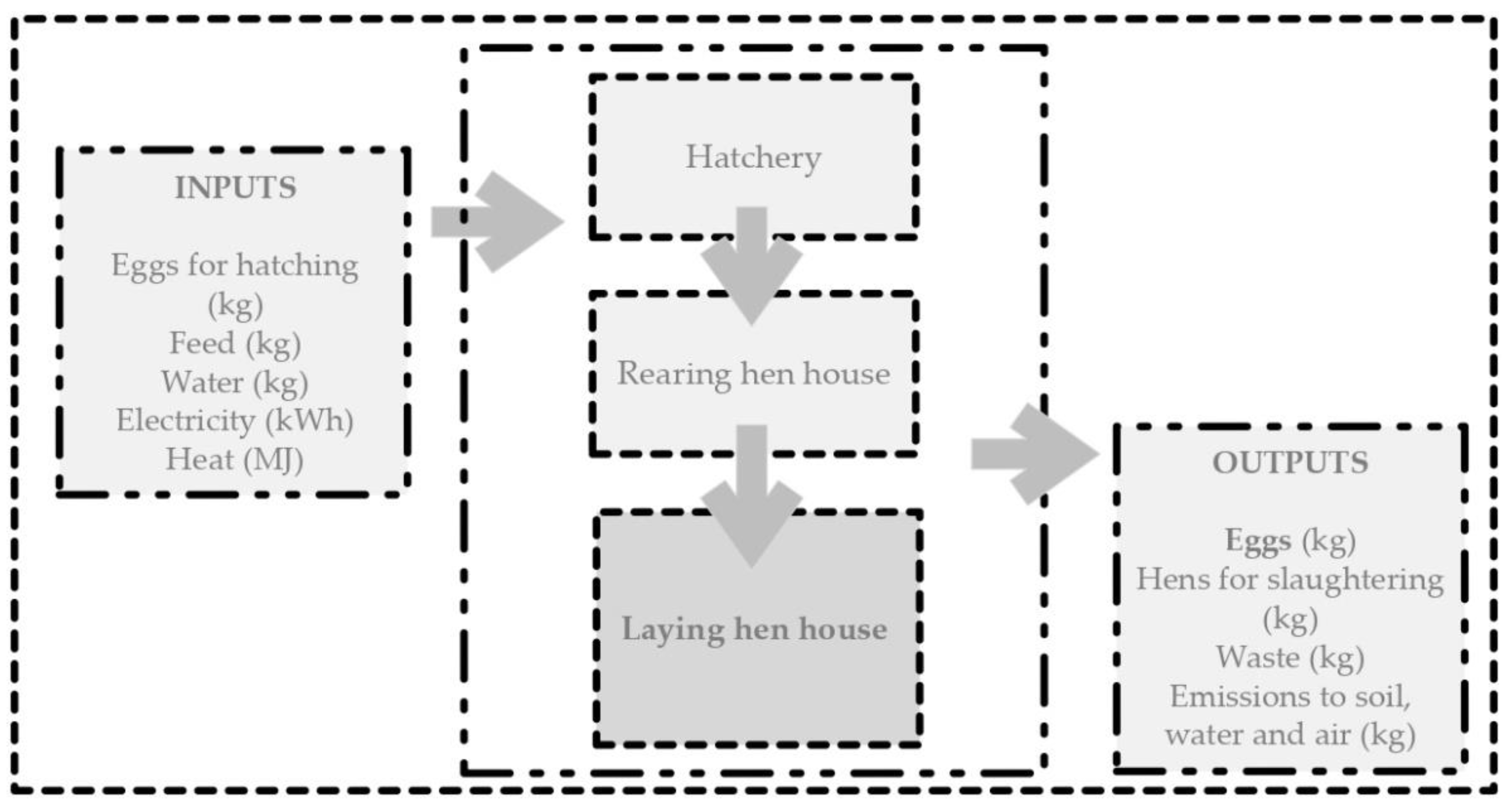
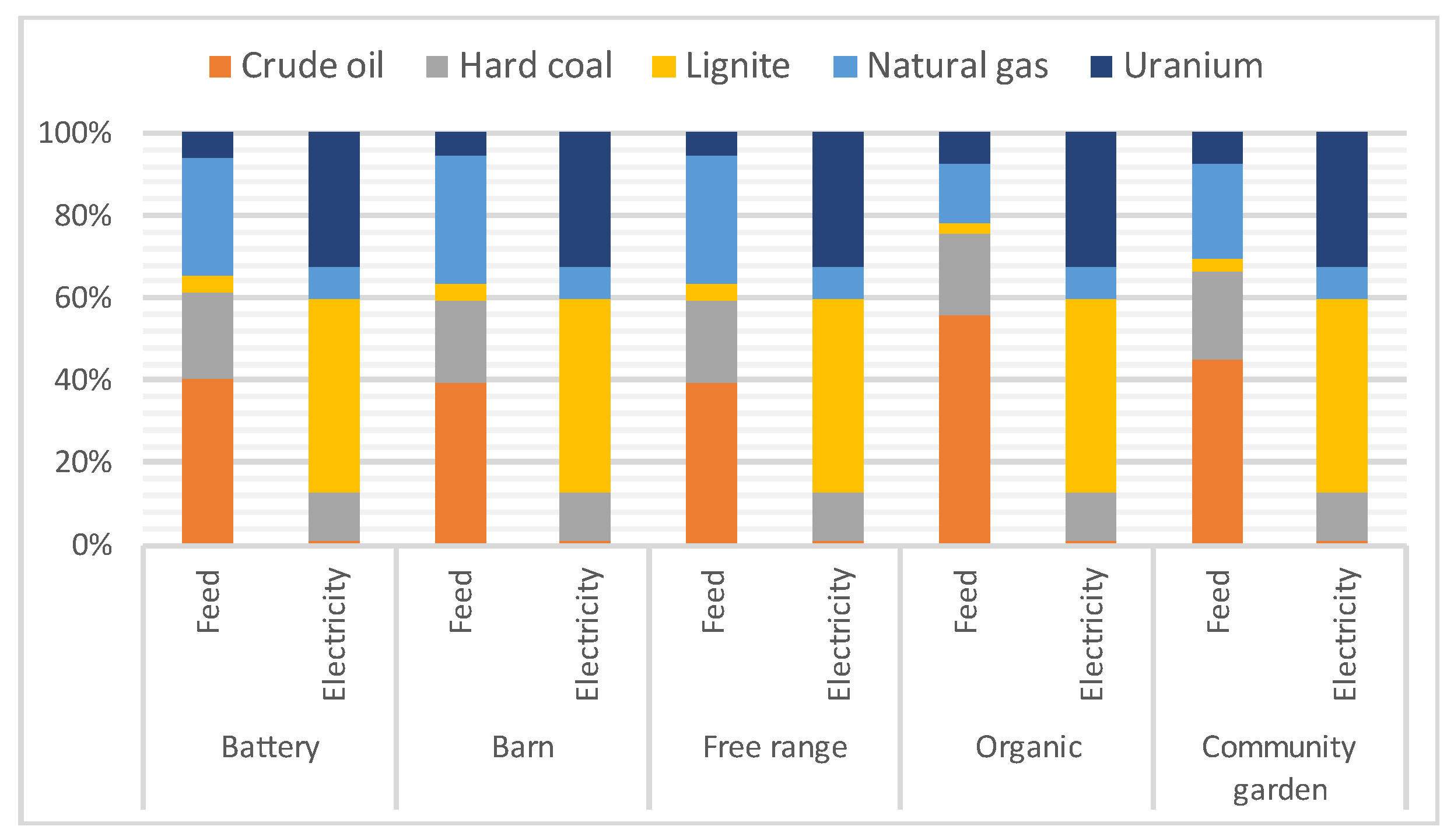
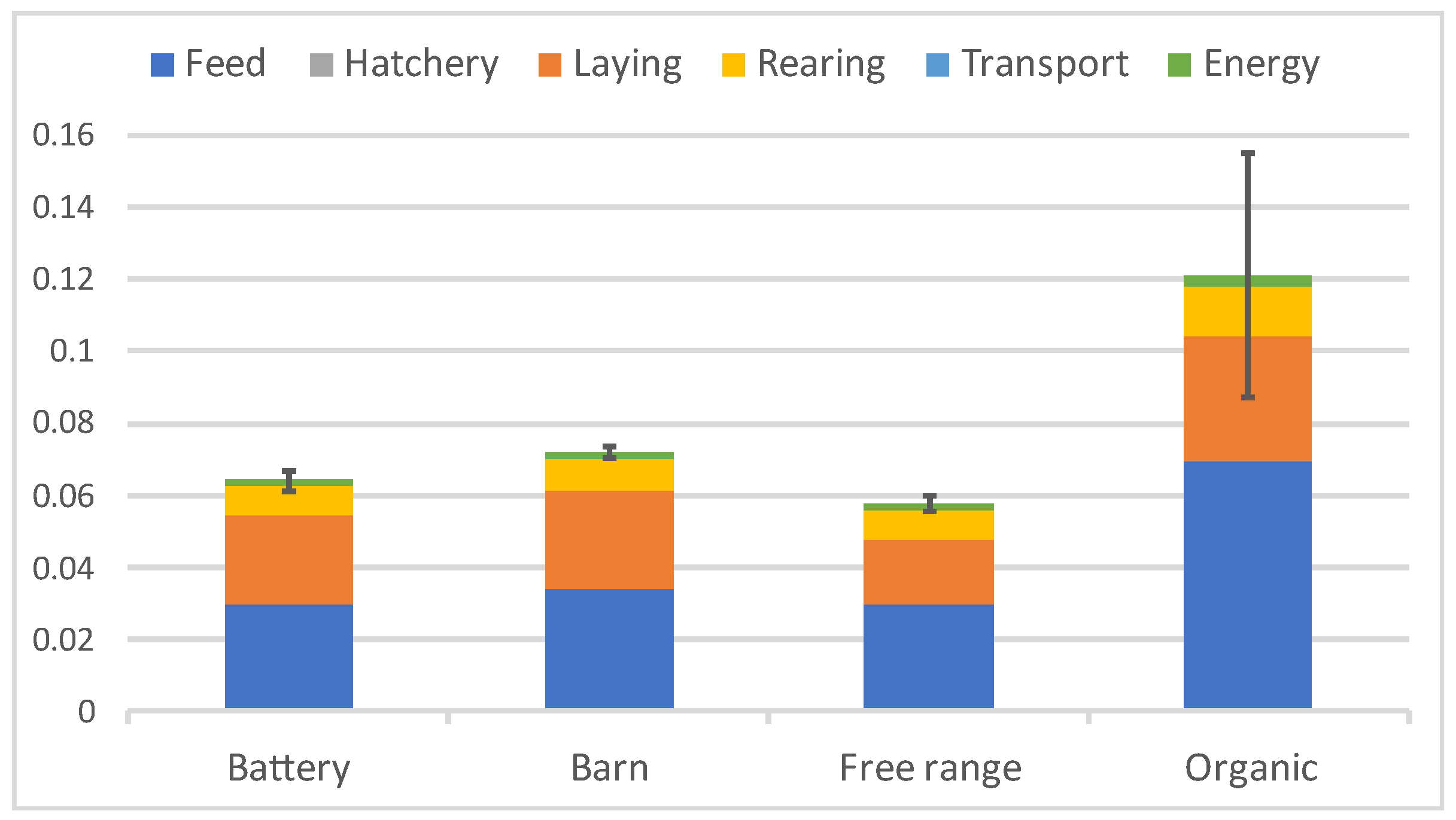
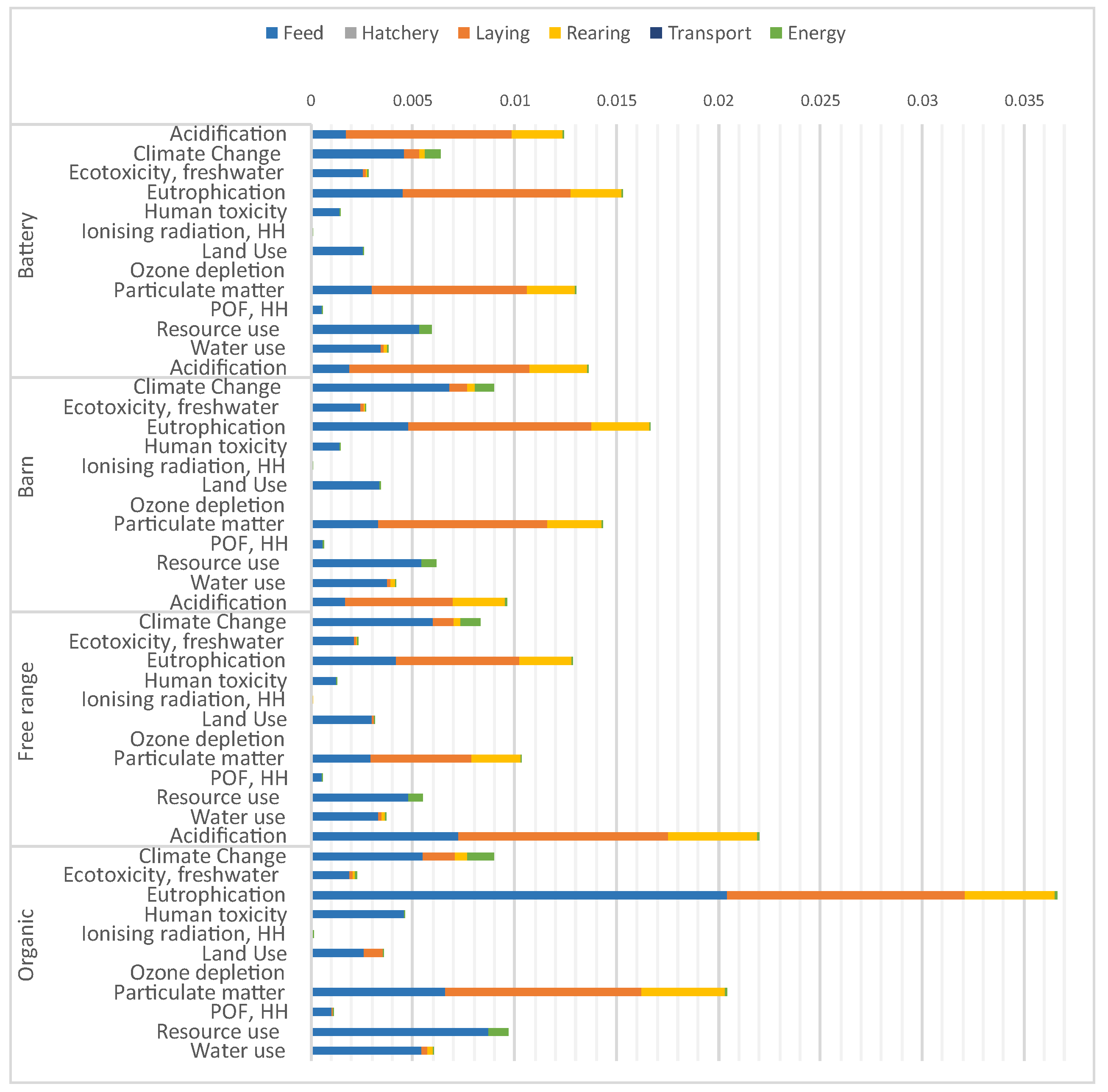
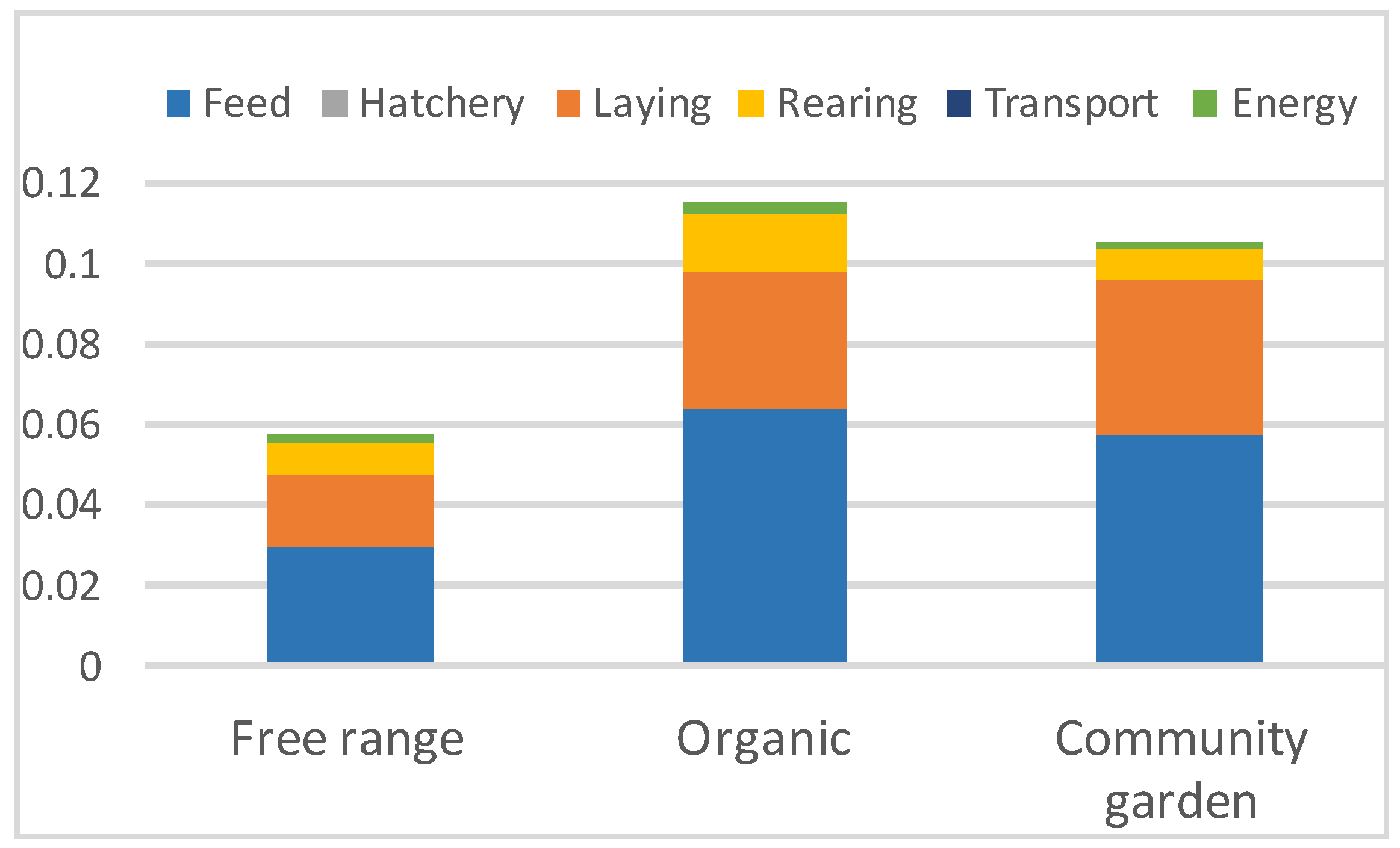
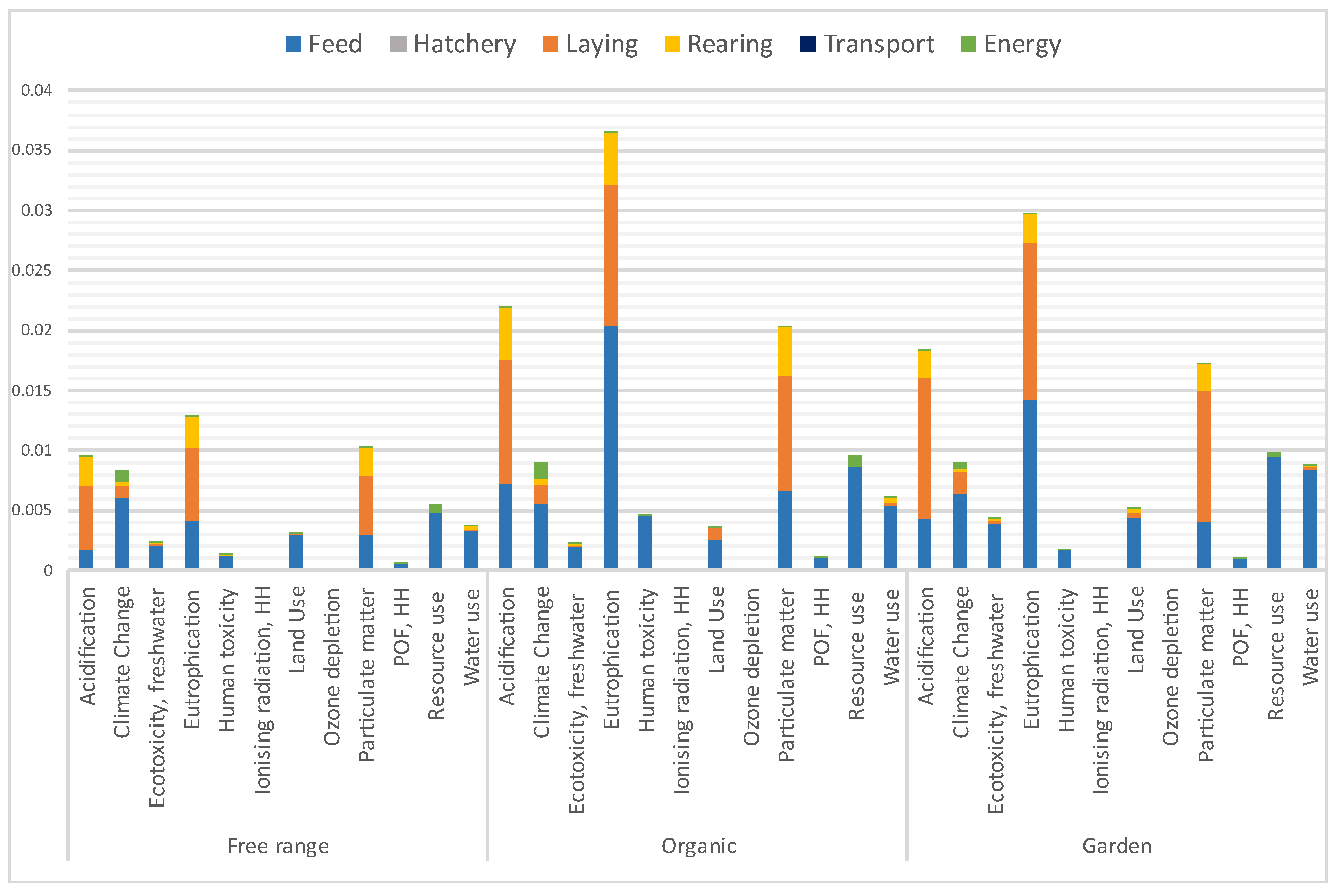
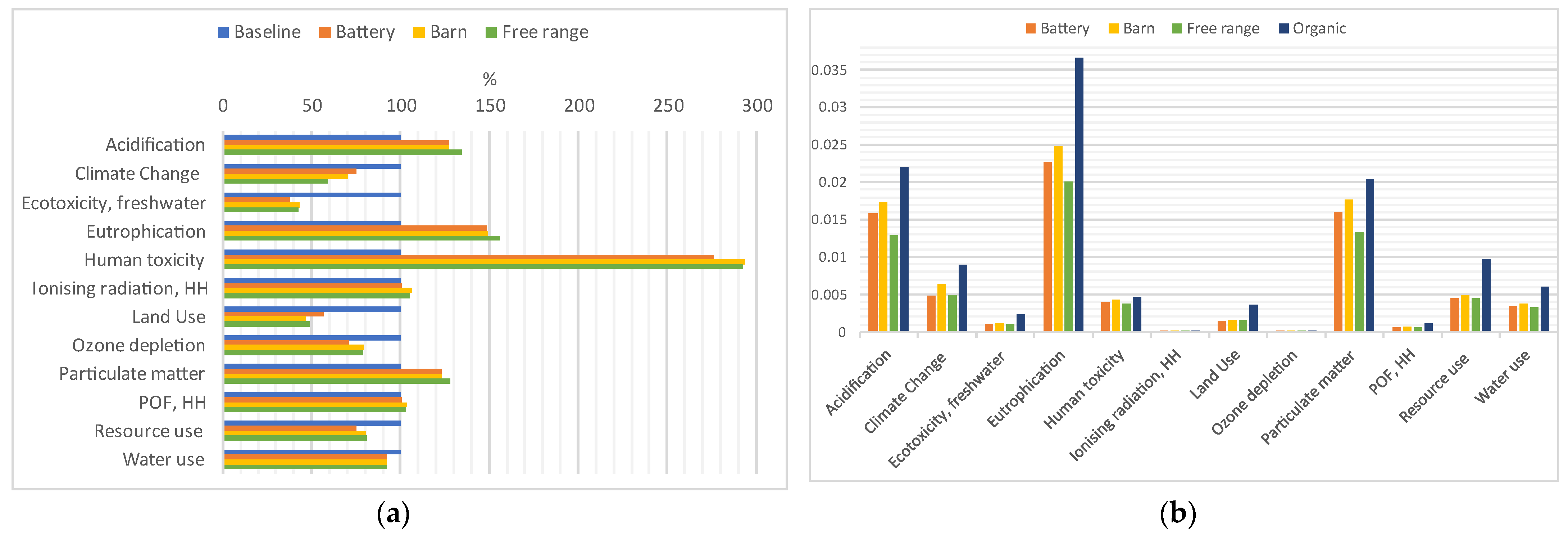
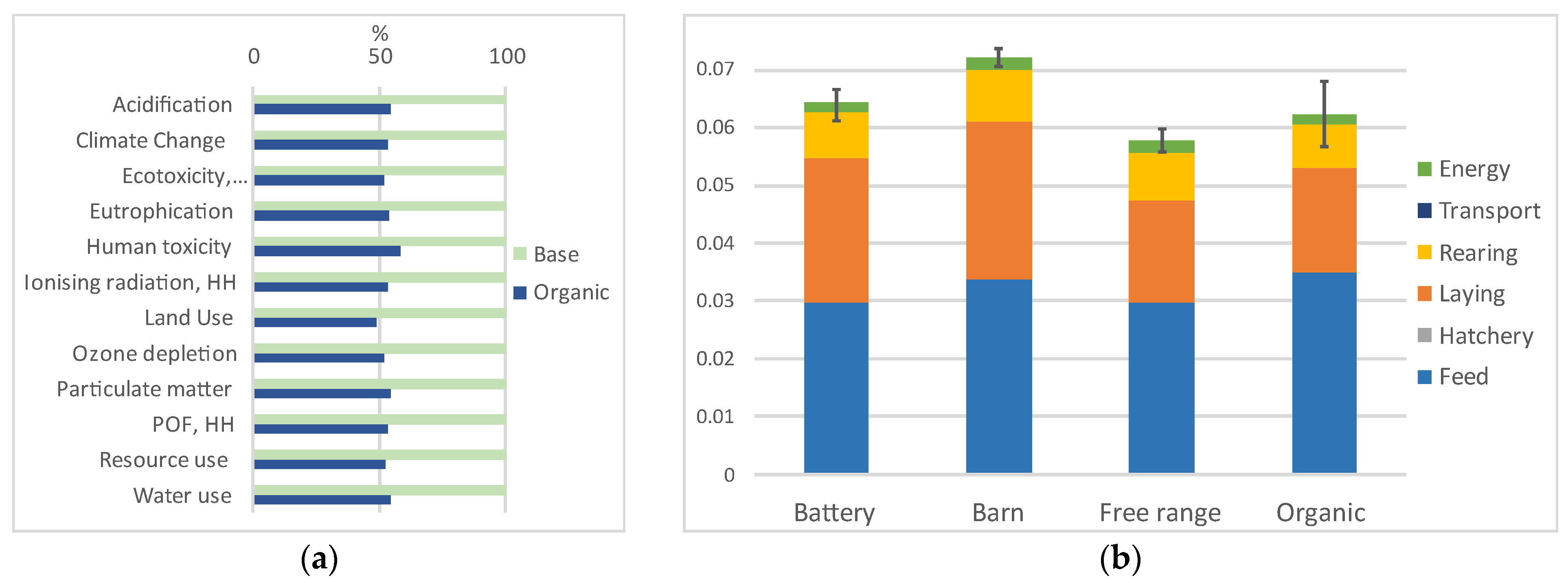
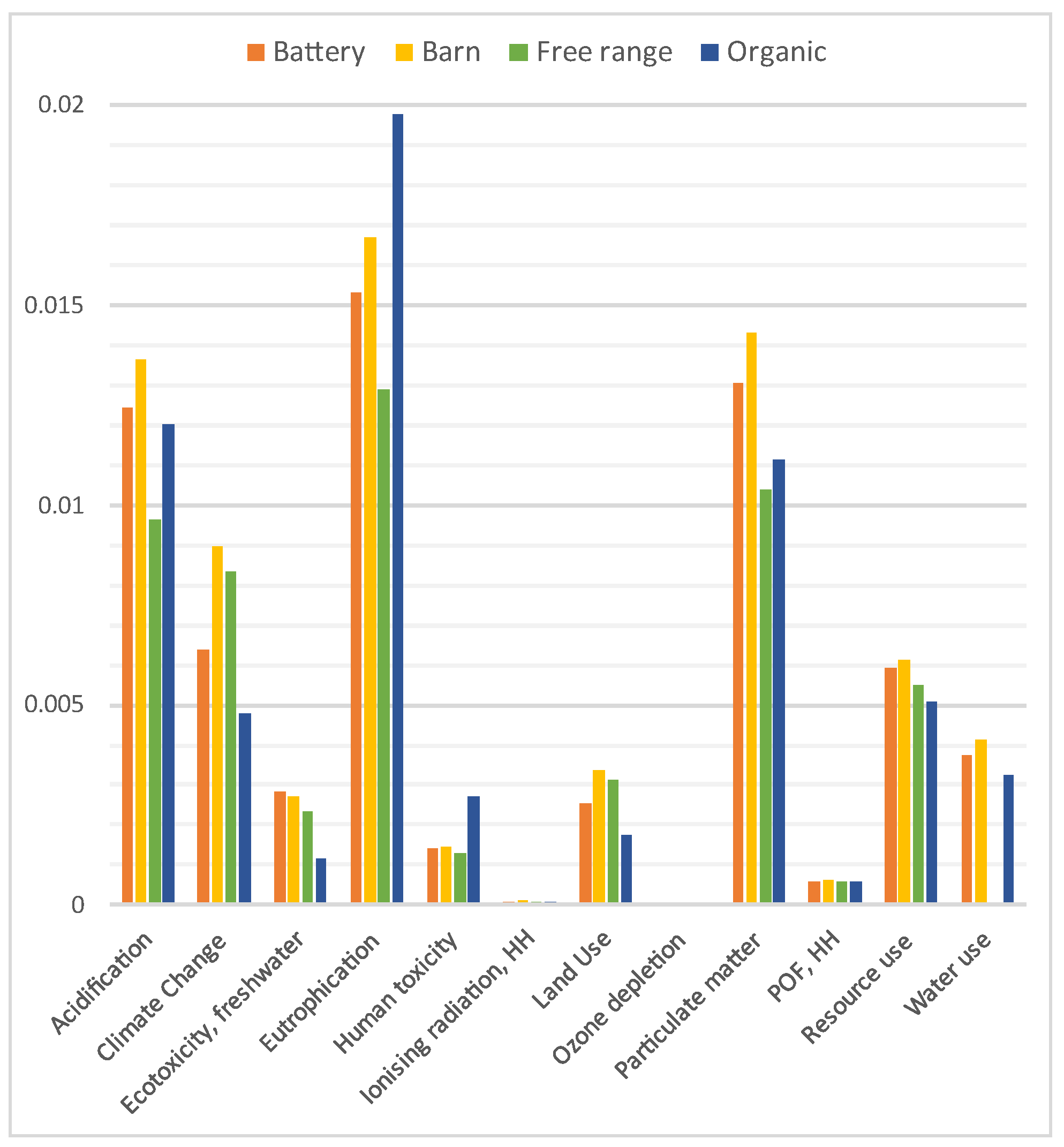
| Hatchery | Rearing (Battery) | Rearing (Barn) | Rearing (Community Garden) | |
|---|---|---|---|---|
| INPUT | ||||
| Area (m²) | 10,412 | 1147.9 | 1256.8 | 800 |
| Eggs (million pieces) | 1200.5 | - | - | - |
| Pullet (number) | - | 29,200 | 25,920 | 15 |
| Electricity (KWh) | 7200 | 167,100 | 182,900 | 0 |
| Heat from natural gas (GJ) | 21,682 | 72.6 | 79.4 | 0 |
| Water (m3) | 21,600 | 3072.6 | 2727.4 | 1.278 |
| Feed (t) | 397.3 | 352.7 | 0.876 | |
| OUTPUT | ||||
| Pullet (number) | 120,000,000 | - | - | - |
| Wastewater (m3) | 21,600 | 19.1 | 16.9 | - |
| N2O (kg/hen) | - | 0.0051 | 0.0051 | 0.0052 |
| NH3 (kg/hen) | - | 0.151 | 0.151 | 0.127 |
| NO3− (kg/hen) | - | 0.197 | 0.197 | 0.162 |
| CH4 (kg/hen) | - | 0.030 | 0.030 | 0.015 |
| P2O5 (kg/hen) | - | 0.0027 | 0.0027 | 0 |
| Battery 1 | Battery 2 | Battery 3 | Barn 1 | Barn 2 | Free Range 1 | Free Range 2 | Organic 1 | Organic 2 | Community Garden | |
|---|---|---|---|---|---|---|---|---|---|---|
| INPUT | ||||||||||
| Area inside (m²) | 1134 | 2597 | 7546 | 79,010 | 11,776 | 9900 | 4344 | 6 | 25 | 14 |
| Area outside (m²) | 0 | 0 | 0 | 0 | 0 | 600,000 | 224,000 | 150 | 2500 | 786 |
| Hens (number) | 32,000 | 102,400 | 300,000 | 600,000 | 598,732 | 150,000 | 56,000 | 40 | 100 | 130 |
| Electricity (KWh) | 59,839 | 140,921 | 655,000 | 1,455,330 | 1,455,330 | 367,500 | 137,715 | 0 | 0 | 0 |
| Feed (t) | 1600 | 4298 | 12,384 | 25,800 | 25,700 | 6077 | 2351 | 2.34 | 5.475 | 7.59 |
| Water (m3) | 1600 | 8532 | 24,875 | 66,729 | 51,187 | 15,570 | 5803 | 3.358 | 12.775 | 11.072 |
| OUTPUT | ||||||||||
| Eggs (number/hen) | 352 | 328.5 | 307 | 287.54 | 300 | 299 | 325 | 228 | 149.65 | 146 |
| FCR (kg feed/kg of eggs produced) | 2.197 | 1.979 | 2.078 | 2.314 | 2.213 | 2.017 | 1.923 | 3.72 | 5.304 | 4.966 |
| Wastewater (kg) | 25 | 52.5 | 830 | 954.46 | 922.7 | 240 | 80 | 0 | 0 | 0 |
| N2O (kg/hen) | 0.0186 | 0.0156 | 0.0153 | 0.016 | 0.016 | 0.0194 | 0.0201 | 0.0166 | 0.0259 | 0.0265 |
| NH3 (kg/hen) | 0.555 | 0.466 | 0.458 | 0.478 | 0.478 | 0.312 | 0.323 | 0.266 | 0.415 | 0.425 |
| NO3− (kg/hen) | 0.723 | 0.607 | 0.596 | 0.623 | 0.623 | 0.766 | 0.794 | 0.655 | 1.020 | 0.861 |
| CH4 (kg/hen) | 0.03 | 0.03 | 0.03 | 0.03 | 0.03 | 0.015 | 0.015 | 0.015 | 0.015 | 0.015 |
| P2O5 (kg) | 0.018 | 0.015 | 0.014 | 0.015 | 0.015 | 0.014 | 0.015 | 0.007 | 0.009 | 0.0001 |
| Ingredient | Rearing | Battery/Barn/Free Range | Organic 1 1 | Organic 2 | Community Garden |
|---|---|---|---|---|---|
| Grounded maize | 10 | 8.38 | - | - | - |
| Grounded wheat | 57.84 | 49.03 | 47 | - | - |
| Grounded soy | 12.7 | 10.72 | - | - | - |
| Grounded triticale | 4.1 | 7.61 | - | 40 | - |
| Rapeseed pellets | 3.9 | 3.68 | - | - | - |
| Maize meal 2 | 0 | 3.09 | - | - | - |
| Sunflower meal | 4.5 | 3.77 | - | - | - |
| Animal fat | 0 | 1.05 | - | - | - |
| Calcium carbonate | 4.5 | 4.67 | - | - | - |
| Grass and worms | - | - | 23 | - | 25 |
| Grain mix (12.3% CP 3) | - | - | - | - | 75 |
| Potato | - | - | 16 | - | - |
| Oats | - | - | - | 10 | - |
| Grain mix (20.9% CP) | - | - | - | 50 | - |
| Energy Resources (MJ) | Battery | Barn | Free Range | Organic | Community Garden |
|---|---|---|---|---|---|
| Non-renewable energy resources | 13.33 | 14.97 | 14.03 | 20.29 | 17.16 |
| Renewable energy resources | 44.18 | 48.19 | 42.55 | 111.15 | 70.54 |
| Impact Category | Battery | Barn | Free Range | Organic | Community Garden |
|---|---|---|---|---|---|
| Acidification (Mole of H+ eq.) | 0.111 | 0.123 | 0.086 | 0.198 | 0.165 |
| Climate change (kg CO2 eq.) | 2.46 | 3.45 | 3.21 | 3.46 | 3.48 |
| Ecotoxicity, freshwater (CTUe) | 62.87 | 60.25 | 52.35 | 50.5 | 95.1 |
| Eutrophication, freshwater (kg P eq.) | 0.000424 | 0.000477 | 0.00042 | 0.000944 | 0.00119 |
| Eutrophication, marine (kg N eq.) | 0.029 | 0.030 | 0.028 | 0.11 | 0.083 |
| Eutrophication, terrestrial (mole of N eq.) | 0.489 | 0.537 | 0.377 | 0.876 | 0.723 |
| Human toxicity, cancer (CTUh) | 2.31 × 10−9 | 2.22 × 10−9 | 1.96 × 10−9 | 6.19 × 10−9 | 4.29 × 10−9 |
| Human toxicity, non-cancer (CTUh) | 1.4 × 10−7 | 1.47 × 10−7 | 1.3 × 10−7 | 4.79 × 10−7 | 1.51 × 10−7 |
| Ionising radiation, HH (kBq U235 eq.) | 0.078 | 0.084 | 0.081 | 0.14 | 0.12 |
| Land use (Pt) | 264.28 | 349 | 320.5 | 368.12 | 562.49 |
| Ozone depletion (kg CFC-11 eq.) | 8.46 × 10−8 | 8.34 × 10−8 | 7.34 × 10−8 | 1.38 × 10−7 | 1.47 × 10−7 |
| Particulate matter (disease incidences) | 8.67 × 10−7 | 9.53 × 10−7 | 6.89 × 10−7 | 1.36 × 10−6 | 1.26 × 10−6 |
| POF, HH (kg NMVOC eq.) | 0.0051 | 0.0054 | 0.0049 | 0.0096 | 0.0087 |
| Resource use, fossils (MJ) | 13.33 | 14.95 | 14.05 | 20.3 | 17.16 |
| Resource use, mineral and metals (kg Sb eq.) | 3.56 × 10−5 | 3.55 × 10−5 | 3.13 × 10−5 | 5.97 × 10−5 | 6.95 × 10−5 |
| Water use (m3 world eq.) | 5.04 | 5.54 | 4.90 | 8.09 | 11.80 |
| Study | Country | Battery | Barn | Free Range | Organic | |
|---|---|---|---|---|---|---|
| Pelletier et al. | Canada | FCR | 2.2 | 2.1 | 2.2 | 2.0 |
| Kg CO2 eq | 2.31 | 2.4 | 2.4 | 1.37 | ||
| Rocío et al. | Spain | FCR | 2.8 | - | - | - |
| Kg CO2 eq | 3.4 | - | - | - | ||
| Constantini et al. | Italy | FCR | 2.49 | |||
| Kg CO2 eq | - | - | - | 1.46 | ||
| Leinonen et al. | United Kingdom | FCR | 2.15 | 2.4 | 2.55 | 2.69 |
| Kg CO2 eq | 2.92 | 3.45 | 3.38 | 3.42 | ||
| Dekker et al. | Netherlands | FCR | 1.99 | 2.28 | 2.33 | 2.59 |
| Kg CO2 eq | 2.24 | 2.67 | 2.74 | 2.55 | ||
| Our study | Czech Republic | FCR | 2.08 | 2.26 | 1.97 | 4.51 |
| Kg CO2 eq | 2.46 | 3.45 | 3.41 | 3.46 |
Publisher’s Note: MDPI stays neutral with regard to jurisdictional claims in published maps and institutional affiliations. |
© 2022 by the authors. Licensee MDPI, Basel, Switzerland. This article is an open access article distributed under the terms and conditions of the Creative Commons Attribution (CC BY) license (https://creativecommons.org/licenses/by/4.0/).
Share and Cite
Guillaume, A.; Hubatová-Vacková, A.; Kočí, V. Environmental Impacts of Egg Production from a Life Cycle Perspective. Agriculture 2022, 12, 355. https://doi.org/10.3390/agriculture12030355
Guillaume A, Hubatová-Vacková A, Kočí V. Environmental Impacts of Egg Production from a Life Cycle Perspective. Agriculture. 2022; 12(3):355. https://doi.org/10.3390/agriculture12030355
Chicago/Turabian StyleGuillaume, Aurore, Anna Hubatová-Vacková, and Vladimír Kočí. 2022. "Environmental Impacts of Egg Production from a Life Cycle Perspective" Agriculture 12, no. 3: 355. https://doi.org/10.3390/agriculture12030355
APA StyleGuillaume, A., Hubatová-Vacková, A., & Kočí, V. (2022). Environmental Impacts of Egg Production from a Life Cycle Perspective. Agriculture, 12(3), 355. https://doi.org/10.3390/agriculture12030355






